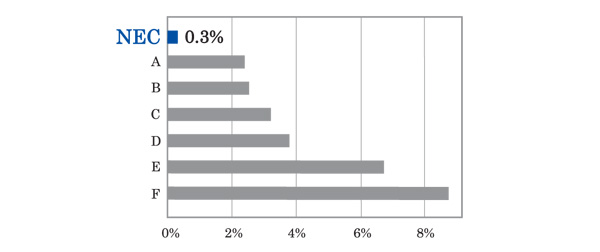| Development and Commercial Implementation of a Pattern Learning Method using Generalized Learning Vector Quantization |
| Atsushi Sato |
 Atsushi Sato Atsushi Sato |
@Learning Vector Quantization and Generalized Probabilistic Descent methods, which generate reference patterns automatically by learning, are known as efficient methods for recognizing patterns. A convergence property in learning is important for improving pattern recognition accuracy, but these conventional methods have a drawback with regard to uncertain convergence properties, which leads to a degradation in accuracy. The recipient of this Achievement Award paid attention to the fact that the reference patterns move in multi-dimensional space while receiving attractive and repulsive forces. He proved for the first time in the world that the dynamical equilibrium point is located at infinity in the conventional methods, which is the reason why we cannot reach it in a finite time. In addition, the recipient succeeded in developing a new learning criterion to solve the convergence problem in generating reference patterns, which guarantees that the dynamical equilibrium point is located in a finite range. Since the proposed learning criterion can be applied to any kind of classifiers, the recipient has developed Generalized Learning Vector Quantization (GLVQ) as a learning method of reference patterns based on that. GLVQ has achieved practical performance even in large scale multi-class recognition problems, to which multi-layered neural networks or Support Vector Machines cannot be applied.
@In the early stages, GLVQ was put to practical use in character recognition in postal automation systems and optical character readers. Kanji character recognition is known as a hard problem because the number of classes of Kanji character is more than 3,000, but this technology achieves high recognition accuracy enabling multi-class large-scale learning. Moreover, the style of handwritten characters is quite different in different nations and regions, so there was a problem that the recognition accuracy is degraded unless a suitable recognition dictionary is used. By utilizing this technology, it becomes easier to make such a suitable recognition dictionary on-site, and character recognition has become sufficiently advanced for practical utilization in a number of countries. In this way, this technology has been introduced to many postal automation systems and contributes to the efficiency and speeding-up of mail delivery worldwide.
@In addition, the recipient has been working on the practical use of GLVQ in the new field of video surveillance such as face recognition, so supporting the realization of a safe and secure society. Face recognition systems equipped with this technology have been introduced in immigration control in several countries, commencing with Hong Kong immigration (Fig. 1), and it achieves satisfactory results in helping the achievement of safety and security worldwide through strict authentication at immigration points. This face recognition system was also introduced in an amusement park as a means of checking annual admission tickets, which led to entertainment by face as well as security. Moreover, NECfs face recognition system was ranked as No.1 in a face recognition benchmark test in 2010 by the National Institute of Standards and Technology (NIST) (Fig.2). The award recipientfs technology made a huge contribution to this. Since the advantages of this technology can be applied to any kind of pattern recognition problem, it is anticipated that this technology will be used in various applications for creating new information of value.

Fig.1@Face recognition gate system at Hong Kong immigration.

Fig.2 Result of face recognition benchmark test by NIST
Comparison of false rejection rates (FRR) when false accept rate (FAR) is
0.1%. NEC achieved less than 1/10 error of others.
(Q)@A. Sato and K. Yamada, gGeneralized learning vector quantization,h Advances in Neural Information Processing Systems 8, pp.423-429, MIT Press, 1996.
(R)@A. Sato, gA formulation of learning vector quantization using a new misclassification measure,h Proc. of 14th ICPR, Brisbane, vol.1, pp.322-325, 1998.
(S)@A. Sato and K. Yamada, gAn analysis of convergence in generalized LVQ,h ICANN98:Proc. of the 8th Intfl Conf. on Artificial Neural Networks, pp.170-176, 1998.
(T)@A. Sato, gDiscriminative dimensionality reduction based on generalized LVQ,h Artificial Neural Networks-ICANN 2001, LNCS 2130, pp.65-72, Springer, 2001.
(U)@A. Sato, H. Imaoka, T. Suzuki, and T. Hosoi, gAdvances in face detection and recognition technologies,h NEC J. of Adv. Tech., vol.2, no.1, pp.28-34, 2005.